You decide the world’s water crisis is a problem you can help solve. You do your research and make a donation to a water ministry. The water charity takes your donations, combines it with other donations, and drills a water well for a village in need. But what happens in-between your donation and the finished well? Here’s what well drilling in Africa looks like with Set Free as shown through the Brooklyn Corner Community in Liberia.
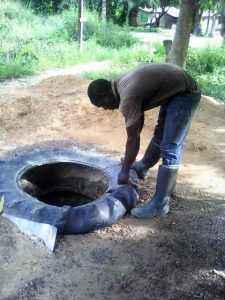
Village Assessment Before Well Drilling in Africa Begins
- Set Free hears about a need for reliable water in Brooklyn Corner. These requests typically come from word-of-mouth, emails, county assessments or other means.
- As soon as we hear about this need and were in the area, Set Free visits Brooklyn Corner and completes our own assessment. We map out how the villagers were currently gathering water, and if it was reliable year-round. CRCA, our pastor partners in Liberia, complete a spiritual assessment of the community. Set Free discovers the villagers collects their water from an open, hand dug well. This well runs dry from November to May each year. It was clear. Brooklyn Center needs a new water well, and the best location to meet the community’s needs is selected. CRCA commits to strengthen the existing churches’ ministries in the community. Cedar Creek Church had donated the funds for a new well (THANK YOU!!!), and Set Free adds Brooklyn Corner Community to our well drilling schedule.
DAY 1 – Preparing the Site for Drilling
- First, the drill rig and crew arrives in the village, and the site is prepped for well drilling. This includes leveling the ground and clearing the brush away.
- The drilling equipment is off-loaded from the trucks and re-assembled to prepare to drill the well. Everything is now ready. Well drilling in Africa will begin the next day.
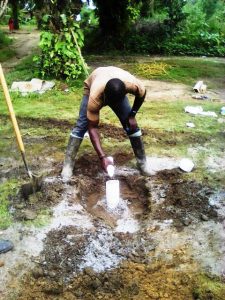
DAY 2 – Water Well Drilling in Africa Begins
- The drill rig completes an initial wet drill at the selected well location until the drill bit hits rock. A wet drill means that water is pumped through the drill stem to flush out dirt, sand, and other debris as the drill digs deeper.
- Ideally, water is found. Provided the drill rig has successfully hit water, we begin to drill a larger 7” hole and flush it clear of debris.
- Slots are cut near the bottom of a 4” PVS pipe casing. This is to allow water to flow into the pipe, and this casing is placed into the newly drilled hole.
- A gravel pack is added at the bottom of the hole surrounding the PVS casing. This gravel pack serves two purposes: it keeps the pipe in place and act as a filter for the water as the water enters the casing and travels up the well.
- The remaining hole around the casing is then back-filled with dirt displaced from the drilling process.
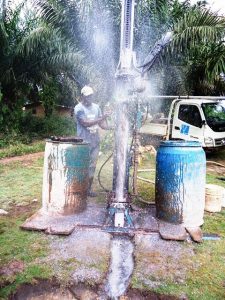
DAY 3 – Water Runs Clean
- If water was not found before hitting rock, the casing is cemented to the rock. A drill called the “down the hole hammer” is used with an air compressor. The down the hole hammer lowers through the casing and begins its work to punch through the rock. This drill will work through 10 feet of rock an hour until it hits water. Drilling through the rock adds anywhere from a few hours to a few days to the drilling time depending on how much deeper it has to go to find water.
- In the case of the Brooklyn Community, water was available before hitting rock so the drill crew is able to start the day by clearing out any sediment added to the water through the drilling process. This is done by pumping out the water until it runs clean. At first, clearing the water is done manually. Later, an air compressor finishes the job.
- The crew then levels and secures the top of the well for a concrete pad. They also create a sanitary seal around the casing by cementing the top several feet of the PVC pipe in concrete. This seal is left to dry overnight.
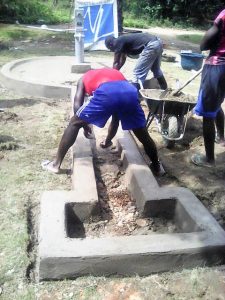
DAY 4 – Cementing the Well Base
- The apron is added to the well. (Well Apron – A 10-foot diameter ring set with concrete blocks and poured concrete that slopes towards the drain.) After smoothing out the last of the concrete, it is left to dry overnight.
DAY 5 – Water Well is Ready to Use
- The last step is the addition of a hand pump. Everything is now left to dry for one more day. This ensures all concrete is completely dry and ready for repeated use.
DAY 6 and Beyond – Life with Clean Water
It is hard to describe, but the Set Free African well drilling crews become a small part of the village while they are there. The crew learns the villager’s stories, and the villagers take care of our drill crews. The village shares their food and helps with the drilling process. The women gather sand to help mix the concrete. If they aren’t working, the men cautiously watch what is going on. Chances are good, it’s also the first time anyone has ever seen a drill rig before. For the purpose of providing desperately needed as clean water, the rig also doubles as village entertainment for the week. And the joy that breaks out on villagers’ faces when clean water begins flowing is indescribable.
And, as always, Set Free’s work of well drilling in Africa is about bringing clean water, but it also goes so much deeper. No longer having to travel long distances for water, children are able to return to school. Mothers are able to care for their families. Almost immediately after the new well is operational, village illnesses decrease. Fathers no longer miss time from work because they are sick. Set Free’s founder, Roland, says it best “When we give a village clean water, the babies stop dying.” What an incredible gift!
Giving clean water is also a tangible example of Christ’s love for all. It is the gift that opens the door to share the gospel of Christ. While our crew is in the village drilling a new clean water well, they also spending time sharing the Gospel. The Jesus Film is often shown one evening, and Bible studies are held. Our pastor partners also join us to start developing the church body.

What You Can Do
We believe Set Free is one of the best investments you can make. Any gift amount will make an impact. As little as $5 will go a long way to loving the unreached and embracing the untouchable. A coffee, a dinner out, a cable subscription – little sacrifices on our end can add up to BIG results in villages around the world. For $3500 you can even adopt an entire village of your own and fund the gift of a brand new bore well. Want to make an even bigger ripple? Pledge to become a THIRST QUENCHER by giving your gift monthly.

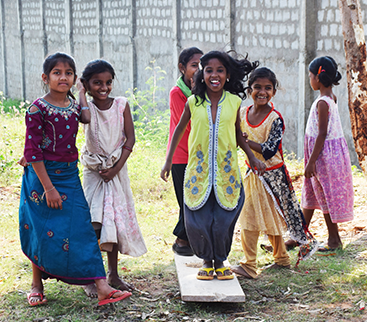





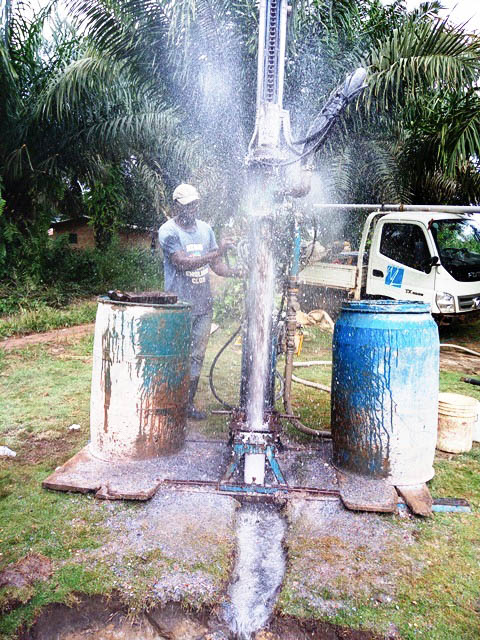
Follow us on social: